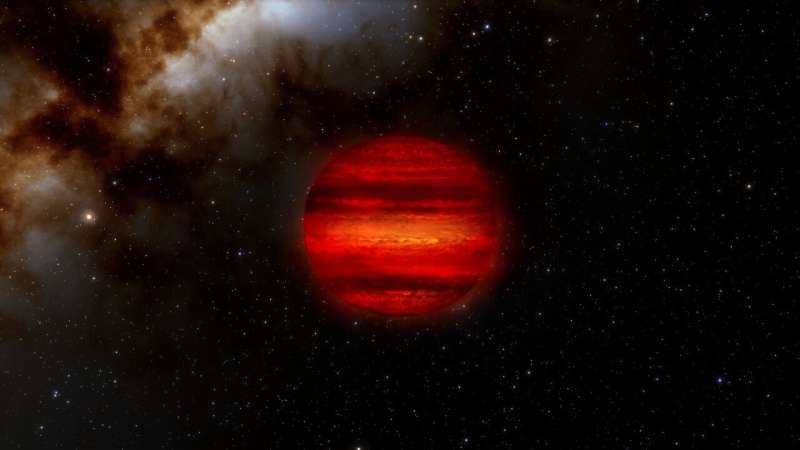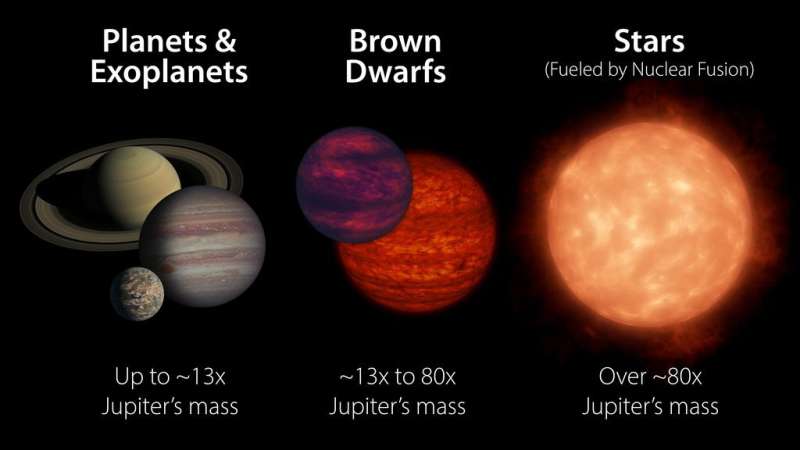Caught speeding: Clocking the fastest-spinning brown dwarfs

Using data from NASA's Spitzer Space Telescope, scientists have identified the three fastest-spinning brown dwarfs ever found. More massive than most planets but not quite heavy enough to ignite like stars, brown dwarfs are cosmic in-betweeners. And though they aren't as well known as stars and planets to most people, they are thought to number in the billions in our galaxy.
In a study appearing in the Astronomical Journal, the team that made the new speed measurements argue that these three rapid rotators could be approaching a spin speed limit for all brown dwarfs, beyond which they would break apart. The rapidly rotating brown dwarfs are all about the same diameter as Jupiter but between 40 and 70 times more massive. They each rotate about once per hour, while the next-fastest known brown dwarfs rotate about once every 1.4 hours and Jupiter spins once every 10 hours. Based on their size, that means the largest of the three brown dwarfs whips around at more than 60 miles per second (100 kilometers per second), or about 220,000 miles per hour (360,000 kilometers per hour).
The speed measurements were made using data from Spitzer, which NASA retired in January 2020. (The brown dwarfs were discovered by the ground-based Two Micron All Sky Survey, or 2MASS, which ran until 2001.) The team then corroborated their unusual findings through observations with the ground-based Gemini North and Magellan telescopes.
Brown dwarfs, like stars or planets, are already spinning when they form. As they cool down and contract, they spin faster, just like when a spinning ice skater draws her arms into her body. Scientists have measured the spin rates of about 80 brown dwarfs, and they vary from less than two hours (including the three new entries) to tens of hours.
With so much variety among the brown dwarf speeds already measured, it surprised the authors of the new study that the three fastest brown dwarfs ever found have almost the exact same spin rate (about one full rotation per hour) as each other. This cannot be attributed to the brown dwarfs having formed together or being at the same stage in their development, because they are physically different: One is a warm brown dwarf, one is cold, and the other falls between them. Since brown dwarfs cool as they age, the temperature differences suggest these brown dwarfs are different ages.
The authors aren't chalking this up to coincidence. They think the members of the speedy trio have all reached a spin speed limit, beyond which a brown dwarf could break apart.
All rotating objects generate centripetal force, which increases the faster the object spins. On a carnival ride, this force can threaten to throw riders from their seats; in stars and planets, it can tear the object apart. Before a spinning object breaks apart, it will often start bulging around its midsection as it deforms under the pressure. Scientists call this oblation. Saturn, which rotates once every 10 hours like Jupiter, has a perceptible oblation. Based on the known characteristics of the brown dwarfs, they likely have similar degrees of oblation, according to the paper authors.
Reaching the Speed Limit
Considering that brown dwarfs tend to speed up as they age, are these objects regularly exceeding their spin speed limit and being torn apart? In other rotating cosmic objects, like stars, there are there natural braking mechanisms that stop them from destroying themselves. It's not clear yet if similar mechanisms exist in brown dwarfs.
"It would be pretty spectacular to find a brown dwarf rotating so fast it is tossing its atmosphere out into space," said Megan Tannock, a Ph.D. candidate at Western University in London, Ontario, and lead author on the new study. "But so far, we haven't found such a thing. I think that must mean that either something is slowing the brown dwarfs down before they hit that extreme or that they can't get that fast in the first place. The result of our paper supports some sort of limit on the rotation rate, but we're not sure of the reason yet."
The maximum spin rate of any object is determined not only by its total mass but by how that mass is distributed. That's why, when very rapid spin rates are involved, understanding a brown dwarf's interior structure becomes increasingly important: The material inside likely shifts and deforms in ways that could change how fast the object can spin. Similar to gas planets such as Jupiter and Saturn, brown dwarfs are composed mostly of hydrogen and helium.

But they are also significantly denser than most giant planets. Scientists think the hydrogen in the core of a brown dwarf is under such tremendous pressures that it starts behaving like a metal rather than an inert gas: It has free-floating conducting electrons, much like a copper conductor. That changes how heat is conducted through the interior and with very fast spin rates, may also affect how the mass inside an astronomical object is distributed.
"This state of hydrogen, or any gas under such extreme pressure, is still very enigmatic," said Stanimir Metchev, co-author on the paper and the Canada Research Chair in Extrasolar Planets at the Institute for Earth and Space Exploration at Western University. "It is extremely challenging to reproduce this state of matter even in the most advanced high-pressure physics laboratories."
Physicists use observations, laboratory data, and mathematics to create models of what brown dwarf interiors should look like and how they should behave, even under extreme conditions. But current models show that the maximum brown dwarf spin speed should be about 50% to 80% faster than the one-hour rotation period described in the new study.
"It is possible that these theories don't have the full picture yet," said Metchev. "Some unappreciated factor may be coming into play that doesn't let the brown dwarf spin faster." Additional observations and theoretical work may yet reveal whether there's some braking mechanism that stops brown dwarfs from self-destruction and whether there are brown dwarfs spinning even faster in the darkness.
The team's results will appear in an upcoming issue of The Astronomical Journal.
More information: Weather on Other Worlds. V. The Three Most Rapidly Rotating Ultra-Cool Dwarfs, arXiv:2103.01990 [astro-ph.SR] arxiv.org/abs/2103.01990
Megan E. Tannock et al. Weather on Other Worlds. V. The Three Most Rapidly Rotating Ultra-cool Dwarfs, The Astronomical Journal (2021). iopscience.iop.org/article/10. … 847/1538-3881/abeb67
Journal information: Astronomical Journal
Provided by NASA




















